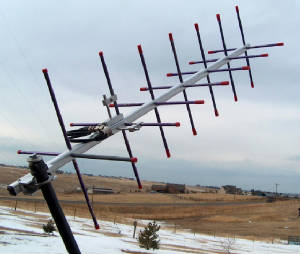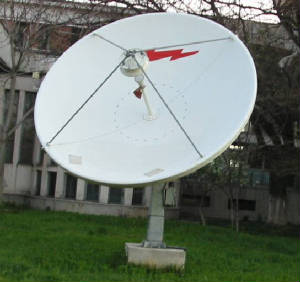|
Getting Started link
AMATER SATELLITE
Currently all Obiting Satellites Carrying Amateur Radio
or O.S.C.A.R. are in some type of a non-goestationary orbit. Some are called L.E.O. for Low Earth Orbit, and some have
a long elliptical orbit that goes far into space before returning. In any case You will have to deal with doppler shift.
That being said, it is common to still make a contact using a hand held antenna, portable high gain antenna, and 5 channel
pairs of frequencies on the radio. Some have even made contacts with the International Space Station.
Tracking link
TRACKING
Since these satellites do not stay in one place, you
will have to track them. There is some software available to do this, and several will even move antenna rotors that
have computer control. There are 3 major pieces of information that is needed . One, is time. You have to
know when you can start to talk, and have to stop. Two, is the Azimuth. This is the compass heading around you.
And third is the Elevation. I will give you an example. Let's Say you see a satellite will come over your horizon
at 12noon, and leave a differnt part of the horizon at 12:10pm. This is a 10 minute window. (common) The Satellite
aproaches at 0 dregrees azimuth (North) and leaves at 90 degrees (East). And lastly, it starts at 0 degrees (horizon),
at it peak it is 45 degrees (1/2 way from horizon and directy above), and back down to the horizon at 0 degrees.
So in this example imagine an invisible arch that at noon, is pointed north at the horizon. Slowly arching
so that at 12:05pm you are pointed North East at 45 dergees. Then by 12:10pm, you are pointing East at the horizon again.
This was just an example, and they can vary a lot in real life. But Hopefully this gave you an idea about tracking.
Satscape Tracking Program
NOVA Tracking Program
DOPPLER SHIFT
Doppler Shift is the drifting of the frequency of a
moving object. You can hear this effect when standing at the side of the road, and a vehicle passes you. As it
approaches you, it slowly decreases in frequency as it aproaches. The frequency change is faster as the object
gets closer. Then when it passes there is a sudden decrease in frequency, and continues to slowly decrease. The
Satellites do the same thing. Also most Satellites have one frequency for the uplink (TX), and a separate one for the
downlink (RX).
RADIOS
Many Radios can do a resonable job. What
is needed is a tranciever that works on two bands, and can receive on one, then transmit on the other. Also have several
memories, usually about 5 memory channels per satellite. Most modern dual band HT's will do fine. Also the Yaesu
FT-847 is a very popular Full Duplexing Radio for satellite use. Full Duplexing allows you to hear yourself on the recieve
of the satellite and to make corrections on the fly. You can use a high gain antenna with low power or a omni-directional
on higher power ( omni-directional has more problems with faraday rotaion). Faraday rotation sounds like the volume
is going up, and down as the satellites is rotating and it's antenna goes in and out of phase with yours. It can be
extemely annoying. For the best performance most hams use circular polarized high gain antennas with a antenna rotor
and elevator.


|

